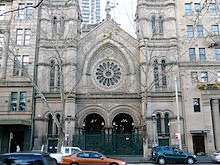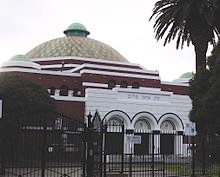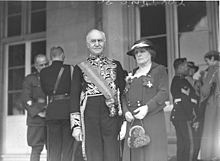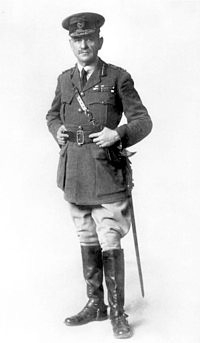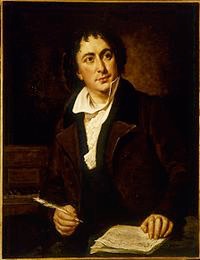Perth, Australia

History of the Jews in Australia
From Wikipedia, the free encyclopedia
The history of the Jews in Australia commenced with the British settlement of Australia in 1788. The first Jews to come to Australia were 8 English convicts transported to Botany Bay in 1788 aboard the First Fleet that established the first European settlement on the continent, on the site of present-day Sydney.[1] There are 97,335 Australians who identified as Jewish in the 2011 census.[2] Jewish citizens make up 0.3 percent of the Australian population.[3] The majority are Ashkenazi Jews, many of them refugees and Holocaust survivors who arrived during and after World War II. Judaism is a minority religion in Australia.
Contents
-
11 History
-
11.1 Colonial era
-
21.2 20th century
-
31.3 Recent history
-
22 Public life
-
33 Commerce
-
44 Arts and culture
-
55 Antisemitism
-
66 Synagogues and religious affiliation
-
77 See also
-
88 References
-
99 External links
History
Colonial era
The Great Synagogue, Elizabeth Street, Sydney, constructed in 1878.
St Kilda Synagogue.
Givat Zion Synagogue, Greenslopes, Queensland.
Australian Jews never constituted more than one per cent of the total colonial community.[4] Eight convicts transported to Botany Bay in 1788 aboard the First Fleet have been identified as Jewish.[5] Exact numbers are not possible, as the transportation records did not indicate a convict's religion. Over a thousand more people of Jewish descent are estimated to have been sent to Australia as convicts during the next 60 years.[1] Most of them came from London, were of working-class background and were male. Only 7% of Jewish convicts were female, compared to 15% for non-Jewish convicts. The average age of the Jewish convicts was 25, but ranged as young as 8 to some elderly people.[6] Ikey Solomon and Esther Abrahams (who arrived with the First Fleet) were amongst the convicts who were Jewish.[4]
At first, the Church of England was the established religion in the colony, and during the early years of transportation all convicts were required to attend Anglican services on Sundays. This included Irish Catholics as well as Jews. Similarly, education in the new settlement was Anglican church-controlled until the 1840s.[6]
The first move towards organisation in the community was the formation of a Chevra Kadisha (a Jewish burial society) in Sydney in 1817.[6] In 1820, the Reverend Dr. Cowper allotted land for the establishment of a Jewish cemetery in the right-hand corner of the then-Christian cemetery. The Jewish section was created to enable the burial of one Joel Joseph. During the next ten years there was no great increase in membership of the society, and its services were not called for more than once a year. The actual allocation of land for a consecrated Jewish cemetery was not approved until 1832.[7]
The first Jewish services in the colony were conducted from 1820 in private homes by emancipist Joseph Marcus, one of the few convicts with Jewish knowledge.[6] An account of the period is:
"In 1827 and 1828 then the worldly condition of the Hebrews in the colony improved considerably, in consequence of the great influx of respectable merchants; and this, with other circumstances, has raised the Hebrews in the estimation of their fellow colonists. About this period Mr. P. J. Cohen having offered the use of his house for the purpose, divine worship was performed for the first time in the colony according to the Hebrew form, and was continued regularly every Sabbath and holiday. From some difference of opinion then existing among the members of this faith, divine service was also performed occasionally in a room hired by Messrs. A. Elias and James Simmons. In this condition everything in connection with their religion remained until the arrival of Rev. Aaron Levi, in the year 1830. He had been a dayyan, and, duly accredited, he succeeded in instilling into the minds of the congregation a taste for the religion of their fathers. A Sefer Torah [scroll of the Law] was purchased by subscription, divine service was more regularly conducted, and from this time may be dated the establishment of the Jewish religion in Sydney. In 1832 they formed themselves into a proper congregation, and appointed Joseph Barrow Montefiore as the first president."
Over the following decades, the community's numbers swelled, primarily as a result of Jewish immigration from the United Kingdom and Germany. As a result, kehillas (organized communities) were established in Sydney (1831) and Melbourne (1841). In 1844, the first synagogue in Australia was built in Sydney. New synagogues were soon built in Hobart (1845), Launceston (1846), Melbourne (1847), and Adelaide (1850).[8]
In 1832, the first Jewish wedding in Australia was celebrated, the contracting parties being Moses Joseph and Rosetta Nathan.[9] Three years later a Mr. Rose came from England and acted as the chazzan, shochet, and mohel. He was succeeded by Jacob Isaacs. The condition of the Jewish community improved to such an extent that in 1844 the first synagogue was formed in York Street, Sydney using rented space,[10] which continued in use for more than thirty years.
The 1841 census shows that at New South Wales Jewry counted for 65.3% of the total Australian Jewish population, and 0.57% of the total Australian population.[4]
Although the Jewish community was primarily Ashkenazi, some Sephardi Jews also immigrated to Australia, and the community thrived during the mid-to-late 19th century. For some twenty years, there was a Sephardic congregation, and some Sephardi families occupied important communal positions. Gradually, however, the Sephardi population declined, and the congregation was disbanded in 1873.[8]
The gold rush of the 1850s attracted a wave of Jewish immigration, and immigrants soon outnumbered native-born Jews. Initially, they settled in rural areas, but by the end of the 19th century, fear of assimilation had caused most Australian Jews to consolidate in the cities. As a result, the rapidly growing community in Sydney required larger facilities, and built the Great Synagogue, located on Elizabeth Street, opposite Hyde Park, which was consecrated in 1878.[8]
In 1895, the first Jewish newspaper, called the Hebrew Standard of Australasia,[11] was published in Sydney, and is the forerunner of the Australian Jewish News.
Throughout the 20th century, many Jews served as elected officials. Among the positions held by a Jew were Mayor of Melbourne, Premier of South Australia, Speaker of the House of Representatives, and Speaker of Parliament. Many Jewish elected officials simultaneously served as the heads of their kehillas. However, the successful integration of Jews into Australian society led to a rise in assimilation. Intermarriage rates rose, synagogue attendance dropped, and many Jews stopped practicing Judaism altogether. However, there were still many who chose to remain observant.[8]
At the end of the 19th century and the beginning of the 20th, as Australia was unifying its colonies into a single independent country, a new wave of Jewish immigration began. Jewish refugees from Russia and Poland began arriving in the 1890s, fleeing pogroms in their native lands. This immigration wave led to a divide among urban Jewish communities. Most Jews in Sydney were from Western and Central Europe, and were largely secular. Meanwhile, Jewish immigrants from Eastern Europe settled in Melbourne, and were highly Orthodox. In addition, thousands of highly observant Jews immigrated from South Africa and settled in Perth.[8]
Jews also began to assemble in Victoria in the 1840s. The Melbourne Hebrew Congregation, Melbourne, formed in 1841, and the first synagogue building opened in 1847, at 472 Bourke Street, with a seating capacity of 100.[12] With the arrival of large numbers of immigrants in the 1850s, the need for a larger synagogue was felt. Construction of a larger 600 seat synagogue at South Yarra commenced in March 1855. This was followed by St Kilda, Geelong, Bendigo, and Ballarat (1853). By the 1850s, during the time of the Victorian Gold Rush, Melbourne had become the largest Jewish settlement in the country. The East Melbourne Hebrew Congregation split from the Bourke St congregation in 1857. A religious court (Beth Din) was set up in Melbourne in 1866. The St Kilda Hebrew Congregation was formed in 1871, with the first services held in St Kilda Town Hall and the building of a permanent building in Charnwood Road commencing in 1872.[13]
20th century
By 1901 it is estimated there were over 15,000 Jews in Australia.[1] When Australia was founded as an independent country in 1901, some of the founders were Jewish. From the outset, Jews were treated as equal citizens with freedom to participate in economic and cultural life, and played an important role in their development. Anti-semitism, which was common in contemporary Europe, was very rare in Australia.[8]
Following World War I, another stream of Jewish immigrants came, and when the Nazis took power in Germany in 1933, many German Jews came to Australia. The Australian government was initially hesitant in permitting entry to the many Jews who wanted to come, but in 1938, it allotted 15,000 visas for "victims of oppression". Some 7,000 Jews took advantage of the visas before the outbreak of World War II.
In the aftermath of World War II and the Holocaust, large numbers of European Jews arrived in the country from displaced persons camps. A large number of the new immigrants were observant Jews, and day-school attendance rose steadily. A new Sephardic community also emerged in the post-war period. Previously, Sephardi Jews were not permitted to enter due to Australia's White Australia policy. However, following the Suez Crisis in 1956, a number of Egyptian Jews were allowed to enter. Over the following years, overtures from Jewish communities led the government to drop its previous stance on entry of Sephardic Jews. By 1969, when Iraqi Jews were being persecuted, the government granted refugee status to Iraqi Jews who managed to reach Australia.[8]
In the 1970s, the Australian Jewish community was concerned by the rising intermarriage rate which impacted the numbers of Jews with bonds to the community. By the early 1980s, intermarriage again dropped to one of the lowest rates in the diaspora. The community was further bolstered by immigration from South Africa, and starting in 1989, from the former Soviet Union.[8]
Recent history
JewishCare is among Australia's largest and oldest Jewish aid organisations, started in 1935 to assist with Jewish migration from Nazi Germany. It is still engaged in assisting migrants and providing other services.[14]
The Jewish community's Jewish Museum of Australia opened in Melbourne in 1982 and the Sydney Jewish Museum opened in 1992 to commemorate The Holocaust, as well as to "challenge visitors' perceptions of democracy, morality, social justice and human rights".[15] There was an increase in immigration from Australia to Israel in 2010, when 240 Australians moved to Israel, up from 165 in 2009.[16][17]
Public life
Sir Isaac Isaacs was the first Australian born Governor General of Australia and was the first Jewish vice-regal representative in the British Empire.
Jews have been mayors of nearly all the capital cities of Australia, as well as of many smaller towns. Numerous Jews have sat in the State and Commonwealth parliaments; and, in proportion to the population, a large percentage have held ministerial portfolios. The first Jew appointed to the Colonial Parliament of New South Wales' Legislative Council in 1854 was prominent merchant, Sir Saul Samuel, who subsequently became a member of the Legislative Assembly and Treasurer and the first Jew to become a minister of the Crown.[18]
Sir John Monash in 1918. Monash was one of the most distinguished Allied commanders of the Western Front during World War One.
Several Jews[which?] have served as State Governors and as Chief Justices of particular states. Sir Julian Salomons was Chief Justice of New South Wales for a fortnight in 1886; the position of Chief Justice of NSW was held by James Spigelman from 19 May 1998 until 31 May 2011. Mahla Pearlman was Chief Judge of the NSW Land and Environment Court from 1992 to 2003, and she was the first woman chief judge in any (State) jurisdiction in Australia. Jews are especially prominent in the legal profession; for example, in Melbourne alone, the Hon. Michael Rozenes sits as Chief Judge of the County Court of Victoria, Justice Redlich sits on the Court of Appeal, while Justices Raymond Finkelstein, Alan Goldberg, Mark Weinberg and Ron Merkel have all sat in recent years on the Federal Court of Australia.
In 1931, Sir Isaac Isaacs was appointed the first Australian born Governor-General, and was the first Jewish vice-regal representative in the British Empire. Sir Zelman Cowen also served as Governor-General, between 1977 and 1982. Sir John Monash, a distinguished Australian Lieutenant-General during World War I, leading Australian troops both in Gallipoli and on the Western Front. The agent-generalship of New South Wales has been administered by two Jews: Sir Saul Samuel, one of the most prominent and successful Jews in Australian politics, and Sir Julian Salomons.
David Bennett is a Sydney barrister. He was president of the Australian Bar Association from 1995 to 1996 and of the NSW Bar Association from 1995 to 1997. Bennett was president of the Association of Lawyer Arbitrators and Mediates in 1998 and President of the Australian Academy of Forensic Sciences from 1999 to 2001. He was Solicitor-General of Australia from 1998 to 2008. Bennett was awarded the Centenary Medal in 2003. His wife, Annabelle Bennett is a Judge of the Federal Supreme Court.
Leo Port (1922–1978) was an electrical and mechanical engineer. He was elected to the Sydney City Council in 1969 representing the Civic Reform group. He served as Lord Mayor between 1975 and 1978. Port was an advocate of civic design, and was partly responsible for the pedestrianisation of Martin Place and Sydney Square. He revolutionized the system of public works and their contracts in Sydney. He was appointed a Member of the Order of the British Empire (MBE) in the New Year's Honours of 1974.
Commerce
Jews in Australia have been successful in business disproportionately to their percentage of the Australian population. Notable for their success in business are Sidney Myer, John Gandel, Peter Abeles, the Smorgon family, Marcus Besen, Eddie Kornhauser, Frank Lowy, Richard Pratt, and Joseph Gutnick. The latter two, along with Sydney gangster Abe Saffron, Rene Rivkin and Rodney Adler, occasionally prospered by less than scrupulous means.[19][20][21]
Among the Jews who have figured as business pioneers in Australia were Joseph Barrow Montefiore (1803–1893)[22] and his brother Jacob Montefiore (1801–1895), one of the founders of the colony of South Australia, as he was selected by the British government to act on the first board of commissioners, appointed in 1835 to conduct its affairs. Jacob's portrait hangs in the Art Gallery of South Australia, and his memory is perpetuated by Montefiore Hill, a vantage point which overlooks the city of Adelaide.[23] Their nephew Jacob Levi Montefiore (1819–1885), whose mother was a first cousin of Sir Moses Montefiore,[24] and J. B. Montefiore gave an impetus to the progress of New South Wales. Jacob owned one of the largest sheep-runs in the colony, and founded and for many years acted as director of the Bank of Australasia. The close connection of these two with the colony is further evidenced by the township of Montefiore, New South Wales, which stands at the junction of the Bell and Macquarie Rivers in the Wellington valley. Joseph Montefiore was the first president of the first Jewish congregation formed in Sydney in 1832.
-
V.L. Solomon of Adelaide is remembered for the useful work he achieved in exploring the vast northern territory of his colony, the interests of which he represented in Parliament. M. V. Lazarus of Bendigo, known as Bendigo Lazarus, also did much to open up new parts in the back country of Victoria. Nathaniel Levi, for many years urged the cultivation of beetroot for the production of sugar and spirits owed its brief existence as an industry to Levi's own interest in raw material for his distilling company. In his labours on behalf of this industry he published in 1870 a work of 250 pages on the value and adaptability of the sugar-beet. In Western Australia, the townships of Karridale and Boyanup owe their existence to the enterprise of M. C. Davies, a large lumber merchant.
-
VI.
Arts and culture
Isaac Nathan c. 1820.[25] Artist unknown, probably one of Lord Byron's portraitists.
Barnett Levy founded an early theatre in Australia. He was refused a license by then governor Darling in 1828, though in the following year he was permitted to hold approved performances in his Sydney Hotel. A record of the event is found in an entry in "Sydney in 1848," a work published in that year: "In the late twenties His Excellency Sir R. Bourke granted Barnett Levy a license for dramatic performances, with a restriction that he should confine himself to the representation of such pieces only as had been licensed in England by the Lord Chamberlain." Levy was at that time the owner of the original Royal Hotel in George Street; and he fitted up the saloon of that establishment as a theatre, where the first representations of the legitimate drama in the colony were given. The encouragement that this undertaking received induced the enterprising proprietor to enlarge his sphere of activity. He built a theatre called the Theatre Royal, which was opened in 1833, at a cost which almost bankrupted him.
Isaac Nathan, who emigrated to Australia in 1841, wrote the first Australian opera, Don John of Austria to a libretto by Jacob Levi Montefiore. It premiered on 3 May 1847 at the Royal Victoria Theatre in Sydney.
There have been Jewish contributions to Australian visual arts. Georges Mora, born Gunter Morawski in 1913 in Leipzig, Germany of Jewish/Polish heritage, fled Germany to Paris in 1930, then to Melbourne in 1949. He established the Tolarno Gallery in Melbourne's bohemian St Kilda. This became a venue for exhibitions of Australian Modernist avant garde art. His wife, Mirka Mora, became a prominent artist and remains so, today. Printmaker and projection artist Ludwig Hirschfeld Mack graduate and professor of the Bauhaus was deported to Australia as an "enemy alien" on the ship HMT Dunera, spending time in internment camps in Hay, Orange and Tatura, before being sponsored for Australian citizenship by (Sir) James Darling, headmaster of Geelong Church of England Grammar School. He was influential in the introduction of Bauhaus principles into visual art and design curricula in Australia. E. P. Fox and Abbey Alston have achieved distinction. Paintings by both these artists have been hung in the Melbourne National Gallery. In the Adelaide Gallery hangs a tribute to the memory of H. Abrahams for the services he rendered to the progress of art in Australia. Two Jews of Australian birth have attained to some distinction as writers, S. Alexander and Joseph Jacobs.
In May 2004, art collector and dealer, Joseph Brown, donated his substantial collection of Australian art of the 20th century to the National Gallery of Victoria. It was the largest single gift of works of art ever made to a public gallery in Australia. Brown migrated from Poland in 1933. He was appointed an Officer of the Order of Australia (AO) for his services to the arts.
Antisemitism
Since the days of European settlement in Australia, Jews have enjoyed formal equality before the law and have not been subject to civil disabilities or other forms of state-sponsored antisemitism excluding them from full participation in public life. Jews have been active contributors in science, art, and literature, and in the government of the colonial and Commonwealth eras, with a number attaining prominent public offices, including several governors-general. Despite this tolerant ethos, Australia rejected a Jewish refugee resettlement proposal, during World War II.
Post-war Jewish immigration came at a time when antisemitism was rife, with the Returned Services League publishing cartoons to encourage the government and Immigration Minister Arthur A. Calwell to stem the flow of immigrants.[citation needed] Attacks on Jewish property and institutions increased with tensions in the Middle East, with corresponding increases in security precautions. In 1975, ASIO documents revealed that Palestinian terrorists planned to kill high-profile Jewish figures including the Israeli ambassador Michael Elizur and "Zionist spokesmen" Isi Leibler and Sam Lipski. Former Prime Minister Bob Hawke, "one of Israel's most vocal supporters", was also considered for attack.[26]
During the progression of the Arab–Israeli conflict, Australia has experienced an increase in attacks on synagogues and violence against persons of Jewish descent[27] which, however, has been significantly less pronounced than in Western Europe and North America. The Jewish community in Melbourne supports an "anti-defamation commission" (ADC) which makes monthly reports to police of offensive graffiti found in public toilets and elsewhere.[28]
Synagogues and religious affiliation
Until the 1930s, all synagogues in Australia were nominally Orthodox, with most acknowledging leadership of the Chief Rabbi of the United Kingdom. To this day the vast majority of synagogues in Australia are Orthodox. However, there is a wide range of Orthodox congregations, including Mizrachi, Chabad and Adass Israel congregations. There are also Sephardi congregations.
There had been short-lived efforts to establish Reform congregations as early as the 1890s. However, under the leadership of Ada Phillips, a sustained liberal congregation, Temple Beth Israel was established in Melbourne. Subsequently another synagogue linked to the United States Reform Movement, Temple Emanuel, was established in Sydney. Following these two congregations, a number of other Liberal synagogues have been founded in other cities.[29]
Since 1992 Conservative (Masorti) services have been held as an alternative service usually in the Neuweg, the smaller second synagogue within Temple Emanuel, Woollahra, Sydney. In 1999, Kehilat Nitzan, Melbourne's first Conservative (Masorti) Congregation was established, with foundation president Prof John Rosenberg. The congregation appointed its first rabbi, Ehud Bandel in 2006. In 2010 Beit Knesset Shalom became Brisbane's first Conservative (Masorti) synagogue.
See also
References
-
1^ Jump up to:
a b c "The Jewish experience in Australia – Fact sheet 217". http://www.naa.gov.au/. National Archives of Australia. Retrieved 7 September 2014. -
2Jump up
^ http://www.jewishnews.net.au/census-shows-jews-are-on-the-move/2663 Australian Jewish News - Census shows Jews are on the move -
3Jump up
^ Colebatch, Tim (2012-06-25). "Census reveals city's changes". Fairfax Media. The Age. Retrieved 7 September 2014. -
4^ Jump up to:
a b c http://judaica.library.usyd.edu.au/histories/History.html Brief History of Australian Jewry -
5Jump up
^ "A history of the Great Synagogue, Sydney". http://www.oztorah.com/. Retrieved 7 September 2014. -
6^ Jump up to:
a b c d Rutland, Susan, 2005, The Jews in Australia, ISBN 0521612853. -
7Jump up
^ V.D. Lipman, A Social History of the Jews of England, 1850–1950, London, 1954, p.121. -
8^ Jump up to:
a b c d e f g h http://www.jewishvirtuallibrary.org/jsource/vjw/australia.html -
9Jump up
^ Suzanne D. Rutland (2008). "Jews". Dictionary of Sydney. Dictionary of Sydney Trust. Retrieved 3 January 2012. -
10Jump up
^ A history of the Great Synagogue, Sydney -
11Jump up
^ "No title.". The Hebrew Standard of Australasia (NSW : 1895 - 1953) (NSW: National Library of Australia). 1 November 1895. p. 3. Retrieved 24 January 2014. -
12Jump up
^ Melbourne Hebrew Congregation – beginnings -
13Jump up
^ St Kilda Shule -
14Jump up
^ http://www.jewishcare.com.au/MintDigital.NET/JewishCare.aspx?xmlNode=1 -
15Jump up
^ "About the Sydney Jewish Museum". Sydney Jewish Museum. Retrieved 8 September 2014. -
16Jump up
^ Ahren, Raphael (1/4/2011). "JA cuts deal to keep immigration emissary Down Under". Haaretz Newspaper. Retrieved 8 September 2014. Check date values in: |date= (help) -
17Jump up
^ Ahren, Raphael (2011-03-25). "JAFI reforms may hurt Australian immigration to Israel, leader says". Haaretz Newspaper. Retrieved 8 September 2014. -
18Jump up
^ Bergman, G. F. J. "Samuel, Sir Saul (1820–1900)". Australian Dictionary of Biography, National Centre of Biography. Australian National University. Retrieved 16 July 2011. -
19Jump up
^ ASIC fines Joseph Gutnick $28M -
20Jump up
^ Rivkin convicted of insider trading and jailed -
21Jump up
^ http://www.theaustralian.com.au/news/dpp-drops-charges-against-dying-pratt/story-e6frg6n6-1225704339699 -
22Jump up
^ Israel Getzler, 'Montefiore, Joseph Barrow (1803–1893)', Australian Dictionary of Biography, National Centre of Biography, Australian National University, http://adb.anu.edu.au/biography/montefiore-joseph-barrow-2472/text3317, accessed 10 May 2013. -
23Jump up
^ "The Late Mr. Jacob Montefiore". Chronicle (Adelaide, SA : 1895 - 1954) (Adelaide, SA: National Library of Australia). 16 November 1895. p. 20. Retrieved 10 May 2013. -
24Jump up
^ Martha Rutledge, 'Montefiore, Jacob Levi (1819–1885)', Australian Dictionary of Biography, National Centre of Biography, Australian National University, http://adb.anu.edu.au/biography/montefiore-jacob-levi-4225/text6813, accessed 10 May 2013. -
25Jump up
^ National Library of Australia nla.pic-an2292675 -
26Jump up
^ Nicholson, Brendan: Palestinian plot to kill Hawke The Age, 1 January 2007 -
27Jump up
^ Skelton, Russell; Smiles, Sarah: Sydney synagogue rocked by attack The Age 1 August 2006 -
28Jump up
^ ‘Best Jew is a dead Jew’ The Australian Jewish News, 12 February 2012 -
29Jump up
^ Rubinstein and Freeman, (Editors), "A Time to Keep: The story of Temple Beth Israel: 1930 to 2005" A Special publication of the Australian Jewish Historical Society, 2005.
External links
-
•Sydney in 1848, by Joseph Fowles, Sydney 1848 (Facsimile reprint 1973, Published by Ure Smith in Association with The National Trust of Australia (NSW))
-
•Culture Victoria – stories and historical images relating to Jewish Australian families
-
•
-
•


